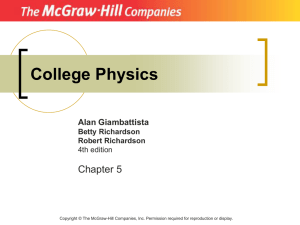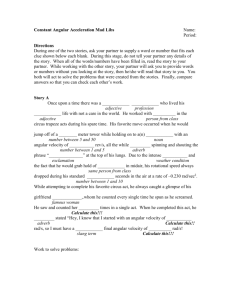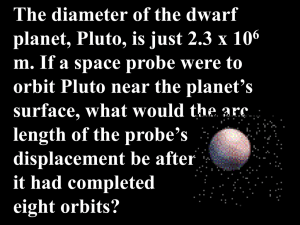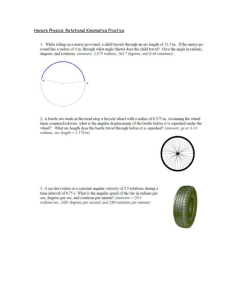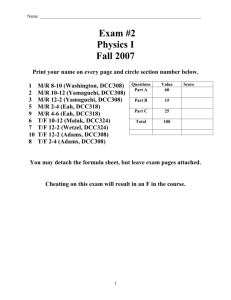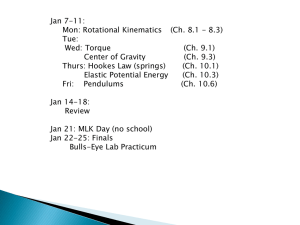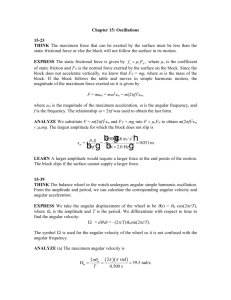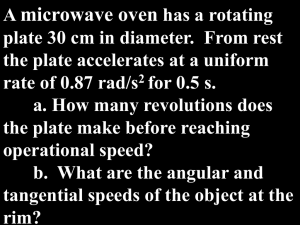4, 7, 9, 12 / 1, 2, 4, 5, 9, 11, 17, 21, 24, 28, 33, 40
advertisement
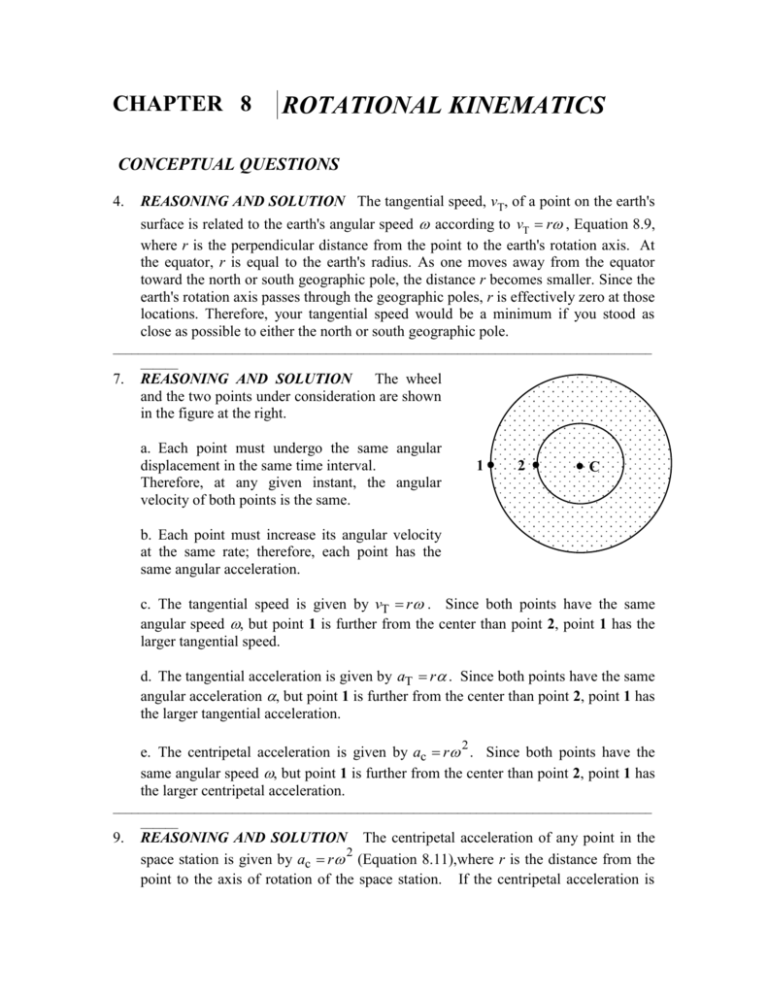
CHAPTER 8 ROTATIONAL KINEMATICS CONCEPTUAL QUESTIONS 4. REASONING AND SOLUTION The tangential speed, vT, of a point on the earth's surface is related to the earth's angular speed according to vT r , Equation 8.9, where r is the perpendicular distance from the point to the earth's rotation axis. At the equator, r is equal to the earth's radius. As one moves away from the equator toward the north or south geographic pole, the distance r becomes smaller. Since the earth's rotation axis passes through the geographic poles, r is effectively zero at those locations. Therefore, your tangential speed would be a minimum if you stood as close as possible to either the north or south geographic pole. ______________________________________________________________________________________ ______ 7. REASONING AND SOLUTION The wheel and the two points under consideration are shown in the figure at the right. a. Each point must undergo the same angular displacement in the same time interval. Therefore, at any given instant, the angular velocity of both points is the same. 1 2 C b. Each point must increase its angular velocity at the same rate; therefore, each point has the same angular acceleration. c. The tangential speed is given by vT r . Since both points have the same angular speed , but point 1 is further from the center than point 2, point 1 has the larger tangential speed. d. The tangential acceleration is given by aT r . Since both points have the same angular acceleration , but point 1 is further from the center than point 2, point 1 has the larger tangential acceleration. e. The centripetal acceleration is given by ac r 2 . Since both points have the same angular speed , but point 1 is further from the center than point 2, point 1 has the larger centripetal acceleration. ______________________________________________________________________________________ ______ 9. REASONING AND SOLUTION The centripetal acceleration of any point in the space station is given by ac r 2 (Equation 8.11),where r is the distance from the point to the axis of rotation of the space station. If the centripetal acceleration is adjusted to be g at a given value of r (such as the astronaut's feet), the centripetal acceleration will be different at other values of r. Therefore, if the adjustment is made so that the centripetal acceleration at the astronaut's feet equals g, then the centripetal acceleration will not equal g at the astronaut's head. 12. REASONING AND SOLUTION The bicycle wheel has an angular acceleration. The arrows are perpendicular to the radius of the wheel. The magnitude of the arrows increases with increasing distance from the center in accordance with vT r , or aT r . The arrows in the picture could represent either the tangential velocity or the tangential acceleration. The arrows are not directed radially inward; therefore, they cannot represent the centripetal acceleration. PROBLEMS ______________________________________________________________________________________ ______ 1. SSM REASONING AND SOLUTION Since there are 2 radians per revolution, and it is stated in the problem that there are 100 grads in one-quarter of a circle, we find that the number of grads in one radian is 1 rev 100 grad (1.00 rad) 63.7 grad 2 rad 0.250 rev ______________________________________________________________________________________ ______ 2. REASONING The average angular velocity is equal to the angular displacement divided by the elapsed time (Equation 8.2). Thus, the angular displacement of the engine is equal to the product of the average angular velocity and the elapsed time. SOLUTION a. Since 2 rad = 1 rev and 1 min = 60 s, the angular speed (in rad/s) of the engine is 2500 rev 2 rad 1 min min 1 rev 60 s 260 rad/s b. The average angular velocity of the engine is equal to the angular displacement divided by the elapsed time t. The angular displacement is 60 s 4 = t 260 rad/s 5.1 min 8.0 10 rad 1 min ______________________________________________________________________________________ ______ (8.2) 4. REASONING AND SOLUTION In one revolution the pulsar turns through 2 radians . The average angular speed of the pulsar is, from Equation 8.2, 2 rad 1.9 102 rad/s t 0.033 s ______________________________________________________________________________________ ______ 5. REASONING AND SOLUTION Using Equation 8.4 and the appropriate conversion factors, the average angular acceleration of the CD in rad/s 2 is 2 210 rev/ min 480 rev/ min 2 rad 1 min 3 2 – 6.4 10 rad/s t 74 min 1 rev 60 s The magnitude of the average angular acceleration is 6.4 10 –3 rad/s 2 . _______________________________________________________________________________ _____________ 9. REASONING AND SOLUTION The angular displacements of the astronauts are equal. For A = sA/rA For B = sB/rB Equating these two equations for and solving for sB gives sB = (rB/rA)sA = [(1.10 103 m)/(3.20 102 m)](2.40 102 m) = 825 m 11. SSM REASONING The time required for the bullet to travel the distance d is equal to the time required for the discs to undergo an angular displacement of 0.240 rad. The time can be found from Equation 8.2; once the time is known, the speed of the bullet can be found using Equation 2.2. SOLUTION From the definition of average angular velocity: the required time is t t 0.240rad 2.53 103 s 95.0rad/s (8.1) Note that because the angular speed is constant. The (constant) speed of the bullet can then be determined from the definition of average speed: v 17. x d 0.850m t t 2.53 103 s 336 m/s REASONING AND SOLUTION a. From Equation 8.7 we obtain SSM 0 t 12 t 2 (5.00 rad/s)(4.00 s) 12 (2.50 rad/s 2 )(4.00 s) 2 4.00 101 rad b. From Equation 8.4, we obtain 0 t 5.00 rad/s + (2.50 rad/s 2 )(4.00 s) = 15.0 rad/s 21. REASONING AND SOLUTION a. = 12 ( + 0 ) t = 1 (1420 rad/s + 420 rad/s)(5.00 2 s) = 3 4.60 10 rad b. = 0 t = 1420 rad/s 420 rad/s = 2.00 102 rad / s2 5.00 s ______________________________________________________________________________________ ______ 24. REASONING The angular displacement for the interval from 0 to 25.0 s can be obtained by breaking the interval into two segments. During the first segment, from 0 to 15.0 s, the wheel has an constant angular acceleration. During the second segment, from 15.0 to 25.0 s, the angular velocity remains constant so the angular acceleration is zero. We will find the angular displacement for each segment by using the equations of kinematics for rotational motion. The angular displacement for the entire interval is the sum of the two displacements. SOLUTION The angular acceleration 1 during the first segment can be found, since we know that the angular velocity changes from 0 to +7.50 rad/s during a time of 5.00 s: 1 0 t t0 7.50 rad /s 0 rad /s 2 1.50 rad /s 5.00 s 0 s The angular displacement 1 for the first segment (0 to 15.0 s) is (8.4) 1 0,1 t1 12 1 t12 0 rad /s 15.0 s 1 2 1.50 rad /s 15.0 s 2 2 169 rad (8.7) The angular velocity 1 at the end of the first segment is 1 0,1 1 t1 0 rad /s + +1.50 rad /s 2 15.0 s 22.5 rad /s (8.4) The angular displacement 2 for the second segment (15.0 to 25.0 s) is 2 0,2 t 12 2 t 2 22.5 rad /s 10.0 s 1 2 0 rad /s 10.0 s 2 2 225 rad where we have used the fact that the final angular velocity 1 of the first segment becomes the initial angular velocity 0,2 for the second segment. The total displacement is 1 + 2 = 169 rad + 225 rad = 394 rad . ________________________________________________________________________ ______ 28. REASONING AND SOLUTION a. According to Equation 8.9, the tangential speed of the sun is vT r (2.2 10 20 m)(1.2 10 –15 rad/s) = 2.6 105 m/s b. According to Equation 8.2, / t . Since the angular speed of the sun is constant, . Solving for t , we have t 2 rad 1y 1 h 1 day 8 1.7 10 y 15 1.2 10 rad/s 3600 s 24 h 365.25 day 33. REASONING AND SOLUTION The average tangential speed v T of points on the rim of the reel is given by Equation 8.9, vT r (2.5 102 m)(1.9rad/s) 0.048m/s where is the average angular speed. The average tangential speed must equal the average linear speed v of the tape. The length L of tape that passes around the reel in a time t can be found from the definition of average velocity: x t Solving for x and setting x = L gives v (8.7) L v t (0.048 m/s)(7.1 s) 0.34 m 40. REASONING a. According to Equation 8.2, the average angular speed is equal to the magnitude of the angular displacement divided by the elapsed time. The magnitude of the angular displacement is one revolution, or 2 rad. The elapsed time is one year, expressed in seconds. b. The tangential speed of the earth in its orbit is equal to the product of its orbital radius and its orbital angular speed (Equation 8.9). c. Since the earth is moving on a nearly circular orbit, it has a centripetal acceleration that is directed toward the center of the orbit. The magnitude ac of the centripetal acceleration is given by Equation 8.11 as ac = r2. SOLUTION a. The average angular speed is = b. 2 rad 1.99 107 rad /s 7 t 3.16 10 s The tangential speed of the earth in its orbit is vT r 1.50 1011 m 1.99 107 rad/s 2.98 104 m/s c. the sun is (8.2) (8.9) The centripetal acceleration of the earth due to its circular motion around a c r 2 1.50 1011 m 1.99 107 rad /s 2 5.94 103 m /s2 The acceleration is directed toward the center of the orbit. 42. REASONING AND SOLUTION The linear speed of all points on either sprocket, as well as the linear speed of all points on the chain, must be equal (otherwise the chain would bunch up or break). a. Therefore, according to Equation 8.9, the linear speed of the chain as it moves between the sprockets is v T r (9.00 cm)(9.40 rad/s) = 84.6 cm/s (8.11) b. The centripetal acceleration of the chain as it passes around the rear sprocket is, according to Equation 8.11, a c rrear 2 , where vT / rrear . Therefore, 2 v T v T 2 (84.6 cm/s) 2 a c rrear 1.40 10 3 cm/s 2 5.10 cm rrear rrear 47. SSM WWW REASONING AND SOLUTION From Equation 2.4, the linear acceleration of the motorcycle is v v0 22.0m/s0 m/s a 2.44m/s 2 t 9.00s Since the tire rolls without slipping, the linear acceleration equals the tangential acceleration of a point on the outer edge of the tire: a aT . Solving Equation 8.13 for gives aT 2.44 m/s 2 8.71 rad/s2 r 0.280 m
